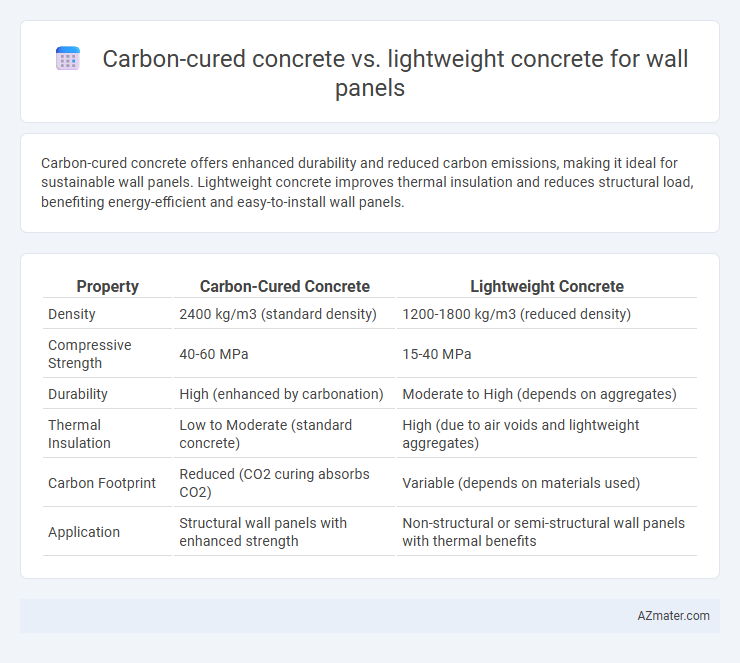Carbon-cured concrete offers enhanced durability and reduced carbon emissions, making it ideal for sustainable wall panels. Lightweight concrete improves thermal insulation and reduces structural load, benefiting energy-efficient and easy-to-install wall panels.
Table of Comparison
| Property | Carbon-Cured Concrete | Lightweight Concrete |
|---|---|---|
| Density | 2400 kg/m3 (standard density) | 1200-1800 kg/m3 (reduced density) |
| Compressive Strength | 40-60 MPa | 15-40 MPa |
| Durability | High (enhanced by carbonation) | Moderate to High (depends on aggregates) |
| Thermal Insulation | Low to Moderate (standard concrete) | High (due to air voids and lightweight aggregates) |
| Carbon Footprint | Reduced (CO2 curing absorbs CO2) | Variable (depends on materials used) |
| Application | Structural wall panels with enhanced strength | Non-structural or semi-structural wall panels with thermal benefits |
Introduction to Wall Panel Construction Materials
Carbon-cured concrete offers enhanced durability and accelerated strength development through accelerated carbonation, making it an innovative choice for wall panel construction materials. Lightweight concrete, characterized by its reduced density and improved thermal insulation, provides easier handling and energy efficiency for wall panels. Selecting between carbon-cured and lightweight concrete depends on factors like load-bearing requirements, environmental impact, and insulation needs in wall panel applications.
Overview of Carbon-Cured Concrete
Carbon-cured concrete accelerates the curing process by injecting carbon dioxide, enhancing strength and reducing permeability compared to traditional methods. This technology not only lowers carbon emissions by sequestering CO2 within the concrete matrix but also improves durability and environmental sustainability in wall panel applications. Lightweight concrete, while beneficial for reducing structural load, does not offer the same carbon capture benefits or enhanced curing efficiency as carbon-cured concrete.
Understanding Lightweight Concrete
Lightweight concrete is specifically engineered using lightweight aggregates such as expanded clay, shale, or pumice, resulting in reduced density and improved thermal insulation properties compared to traditional carbon-cured concrete. Its lower weight decreases structural load and enhances ease of installation, making it a preferred choice for wall panels in multi-story buildings and seismic zones. Performance benefits include better sound absorption, improved fire resistance, and reduced transportation costs due to its lower mass.
Strength and Durability Comparison
Carbon-cured concrete wall panels exhibit higher compressive strength and enhanced durability due to the accelerated carbonation process that densifies the microstructure and reduces porosity. Lightweight concrete panels, while offering reduced weight for easier handling and improved thermal insulation, typically demonstrate lower strength and increased susceptibility to cracking under load. The superior durability of carbon-cured panels makes them ideal for structural applications requiring long-term performance in harsh environments compared to lightweight alternatives.
Environmental Impact and Sustainability
Carbon-cured concrete significantly reduces CO2 emissions by utilizing captured carbon dioxide in the curing process, enhancing durability and environmental performance compared to traditional methods. Lightweight concrete offers improved thermal insulation and reduced material usage, lowering embodied energy and transportation emissions in wall panel applications. Both materials promote sustainability, with carbon-cured concrete advancing carbon sequestration while lightweight concrete minimizes resource consumption and enhances building energy efficiency.
Thermal and Acoustic Insulation Properties
Carbon-cured concrete exhibits superior thermal insulation due to its dense microstructure that minimizes heat transfer, making it highly effective for energy-efficient wall panels. Lightweight concrete offers enhanced acoustic insulation by incorporating air pockets that absorb sound waves, reducing noise transmission in interior spaces. Combining both materials can optimize wall panel performance, balancing thermal retention with soundproofing requirements.
Installation and Handling Differences
Carbon-cured concrete wall panels offer faster installation due to their improved early strength and reduced curing time, allowing quicker lifting and placement compared to lightweight concrete panels. Lightweight concrete panels are easier to handle manually because of their reduced weight, lowering labor effort and transportation costs but may require longer curing periods and additional care during installation to prevent damage. The choice between these materials depends on balancing installation speed with handling convenience and on-site logistics for optimal construction efficiency.
Cost Analysis: Carbon-Cured vs Lightweight Concrete
Carbon-cured concrete wall panels typically incur higher initial costs due to specialized curing equipment and CO2 injection processes, but offer long-term savings through enhanced durability and reduced carbon footprint. Lightweight concrete panels generally have lower upfront expenses attributed to simpler production methods and reduced material density but may require more maintenance over time, impacting total lifecycle cost. Comparing both, carbon-cured concrete offers a cost-effective solution in sustainable construction projects prioritizing environmental impact and long-term savings, while lightweight concrete provides budget-friendly options for immediate cost constraints.
Applications and Ideal Use Cases
Carbon-cured concrete offers enhanced durability and thermal efficiency, making it ideal for load-bearing wall panels in sustainable buildings and infrastructure projects focused on carbon reduction. Lightweight concrete provides excellent insulation and ease of installation, suited for non-structural wall panels, partition walls, and retrofit applications where reducing overall building weight is critical. Both materials are chosen based on specific performance requirements, with carbon-cured concrete favored for environmental benefits and strength, while lightweight concrete emphasizes flexibility and thermal insulation in wall panel applications.
Future Trends in Wall Panel Technology
Carbon-cured concrete offers enhanced durability and reduced carbon emissions, positioning it as a sustainable choice for future wall panel technology. Lightweight concrete provides superior thermal insulation and ease of installation, ideal for energy-efficient building designs. Emerging trends emphasize integrating carbon-cured techniques with lightweight materials to achieve optimal structural performance and environmental impact reduction in wall panel applications.

Infographic: Carbon-cured concrete vs Lightweight concrete for Wall panel
 azmater.com
azmater.com